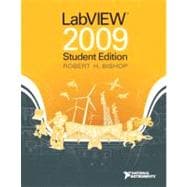National Instruments' LabVIEW is the defacto industry standard for test, measurement, and automation software solutions. With the LabVIEW 2009 Student Edition, students can design graphical programming solutions to their classroom problems and laboratory experiments with software that delivers the graphical programming capabilities of the LabVIEW professional version. . The Student Edition is also compatible with all National Instruments data acquisition and instrument control hardware.
Note: The LabVIEW 2009 Student Edition is available to students, faculty, and staff for personal educational use only. It is not intended for research, institutional, or commercial use. For more information about these licensing options, please visit the National Instruments website at (http:www.ni.com/academic/)
New LabVIEW software features introduced in this new edition:
- Using VI Snippets to store, share, and reuse small portions of LabVIEW code.
- Quickly finding and placing LabVIEW palette objects with Quick Drop.
- Simplified debugging by managing all LabVIEW probes in one window.
- A Block Diagram Cleanup Tool to automatically arrange portions of code.
- An enhanced set of editing tools for creating icons in the Icon Editor dialog box.
- Many new math plots for 2D and 3D graphs, including 2D compass plots, error plots, and feather plots, and 3D bar plots, comet plots, contour, stem, waterfall, and others.








